It’s a condition more common than you might think—but rarely talked about. Whether you’re newly postpartum or just beginning to notice changes in your core, understanding the signs and knowing what steps to take can make all the difference.
What is Diastasis Rectus?
Abdominal muscles form an elaborate corset that supports your stomach contents and your back. The central set of abdominal muscles is the rectus muscles. These are divided into right and left halves, joined together by a thin, fibrous band of connective tissue.
While you are pregnant, your abdominal (six-pack) muscles stretch to allow room for your baby to grow. Diastasis rectus is when these tummy muscles over-stretch during pregnancy and separate down the midline.
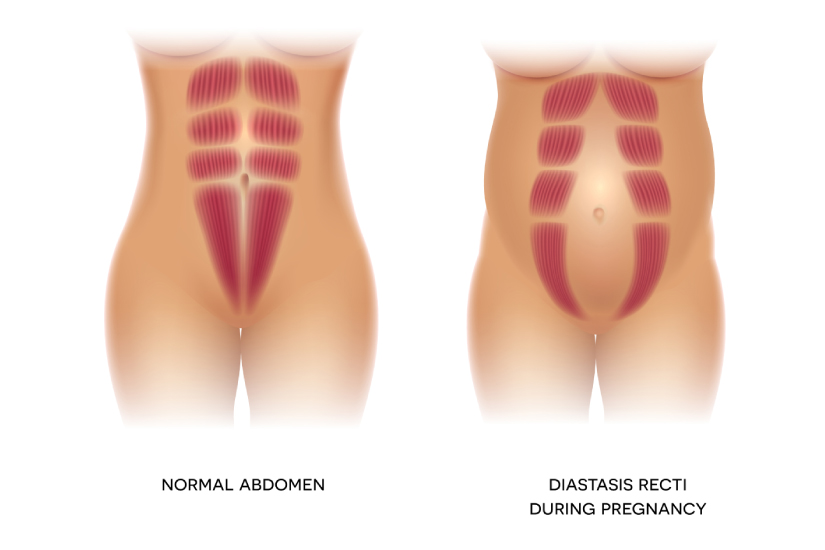
What Causes Diastasis Rectus?
Below are a few reasons that may prove to be responsible for causing diastasis recti.
- Most commonly pregnancy – increased risk with twin or IVF pregnancy due to increased bump size/tissue elasticity
- Many years of abdominal loading/lifting with poor technique
- Chronic straining
- During labor, especially during excessive breath-holding during the second stage
- Obesity
- Hypermobility
- Multiple pregnancies
Identifying Diastasis Rectus?
Lie on your back with your knees bent and feet on the floor. Have your top rolled up so you can see your tummy. Tuck your chin in towards your chest and gently lift your head and shoulders up from the floor. If you have diastasis recti, you will see a dome down the middle of your tummy. This is your abdominal contents pushing through between your abdominal muscles.
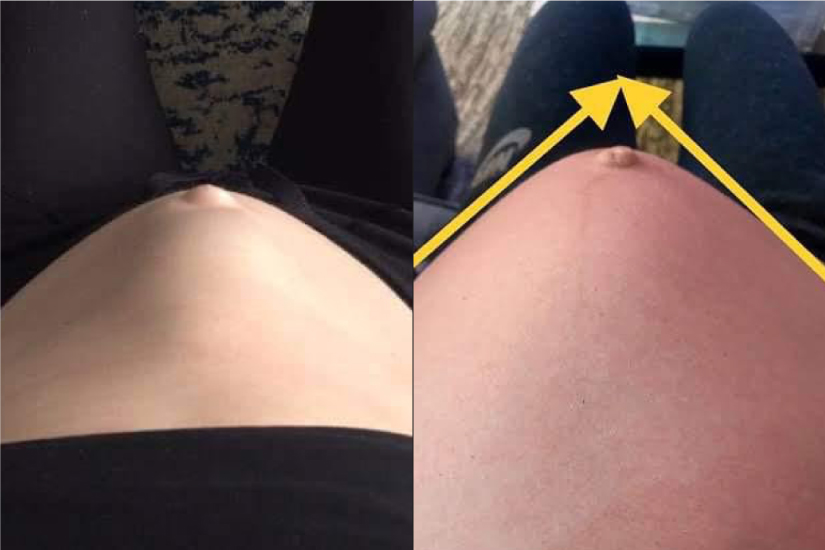
How Does A Physiotherapist Measure Diastasis Rectus?
Your physiotherapist will ask you to lie on your back and feel your tummy muscles while you are relaxed and then while you are activating your abdominal muscles. They will measure the gap between your tummy muscles at your belly button and 2 inches above and below.
Diastasis Recti – Dos and Don’ts
- Avoid all strenuous exercises that cause your abdominal wall to bulge out.
- If you have to bend forward, engage your core muscles before you do exercise 1 mentioned later in the blog.
- Avoid heavy lifting or bending. Learn the form and technique first.
- Avoid straining on the toilet.
- Avoid aggressive abdominal exercises that would put a strain on the midline of the abdominal such as sit-ups or crunches or rising from a lying position by pulling up and twisting at the same time.
- When getting out of bed, roll onto one side first before pushing up, avoiding the sit-up motion.
- Start exercises to strengthen your deep core muscles.
- Start with low-level strengthening working on the deep tummy muscles first.
- Abdominal corset/supports can be useful to help activate your tummy muscles and support your posture initially.
- Physiotherapy can also teach you more strengthening and stretching exercises that may help.
Diastasis Recti Exercises
Exercise 1 – Transverse Abdominus Activation (TAB)
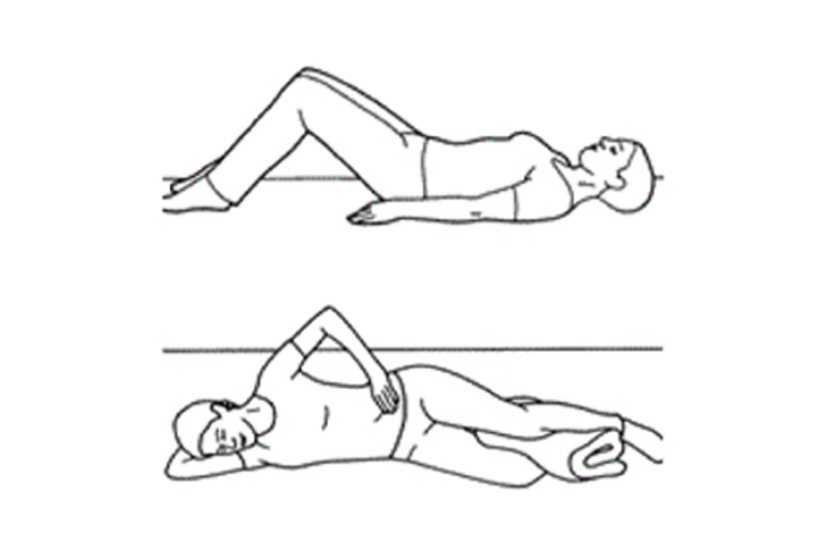
- Lie on your back or your side with your knees bent up and your feet flat.
- Keep the normal inward curve in your lower back throughout.
- Place your fingers on your lower abdominal wall just inside your pelvic bones.
- Imagine you are wearing a low-slung belt across your hips.
- Gently draw in the area between your tummy button and pubic bone towards your spine as if you were trying to do the belt up a few more notches.
- Start by holding this for as long as you can (5-10 secs) Relax. Repeat 10 times.
- Increase how long you hold for as you become stronger, up to 10 seconds.
- You can also try this exercise in sitting or standing when you feel confident.
Exercise 2 – Bent Knee Fall Outs
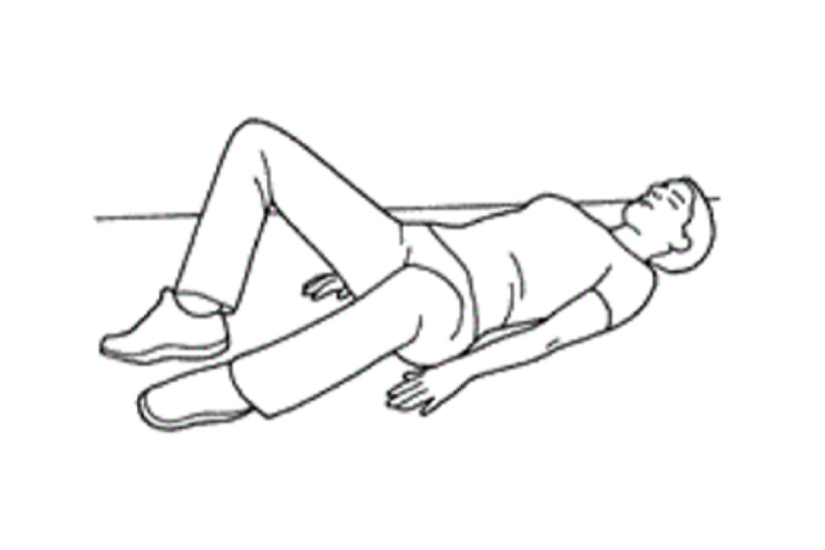
- Start on your back with your knees bent.
- Activate your deep tummy muscles and gently lower your right knee down towards the floor – keep your left knee bent and pointing upwards towards the ceiling.
- Keep your pelvis stable throughout this exercise – try to avoid trunk rotation.
- Return your right leg to the starting position as soon as you detect movement in your trunk.
- Relax your deep abdominal muscles.
- Repeat 2-3 exercises on each side when starting and building up.
Exercise 3 – Heel Slides

- Lie on your back with your knees bent and feet flat.
- Place your fingers to feel your lower abdominal muscles just inside your pelvis and gently activate your deep abdominal muscles.
- Straighten your right leg slowly, sliding your foot along the floor, and then slowly return to the starting position when you feel your lower back begin to arch.
- Repeat 5-7 times on each side when starting.
Exercise 4 – Pelvic Tilt
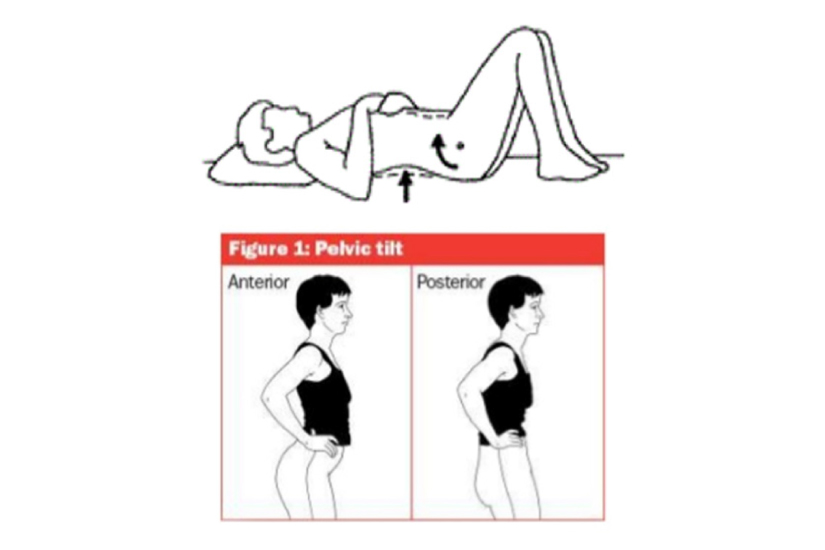
- Start lying on the floor. You can also do this sitting on a chair or gym ball.
- Round your lower back and roll your pelvis backward over your sitting bones.
- Feel the stretch in your lower back.
- Return to the starting position. Repeat 10 times.
Exercise 5 – Pelvic Floor
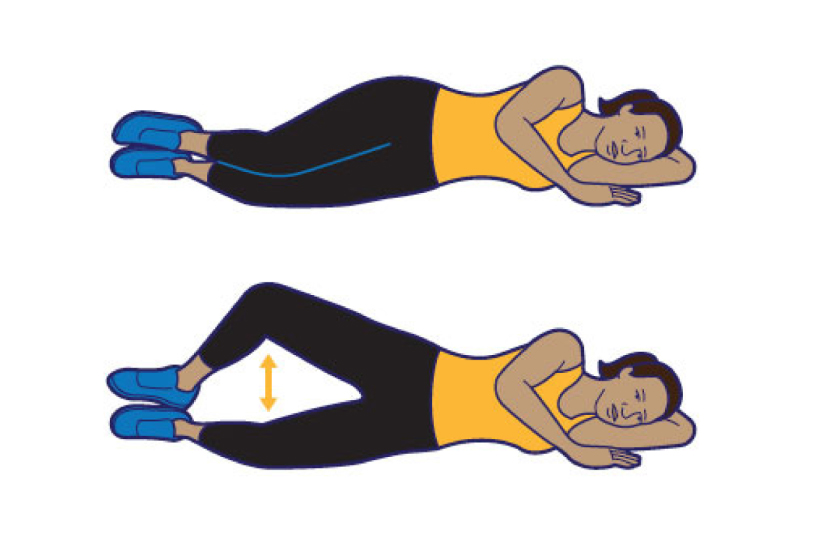
- Lie on your back with your knees bent and feet flat.
- Imagine stopping urine in midstream.
- Inhale while contracting the pelvic floor muscles, ensuring to expand the front, back, and sides of the lower rib cage.
- During exhalation, relax your pelvic floor.
- The contraction should be held for 3-5 seconds, 3 sets of 10.
- While performing this exercise, you should not feel your buttocks tighten or movement in your spine.
Exercise 6 – Diaphragmatic Breathing
- Lie on your back with your knees bent and feet flat.
- A pillow can be placed under the knees for support.
- Place one hand on your chest and one hand over the apex (highest point) of the abdomen.
- Take a deep breath through your nose as if sniffing perfume.
- Hold the breath for 2-3 secs.
- Exhale through your mouth as if blowing a candle.
Conclusion
Diastasis Rectus, a condition characterized by the separation of abdominal muscles, often occurs during pregnancy but can result from various factors. The simple self-test described helps in identification, and physiotherapy plays a crucial role in assessing and managing diastasis rectus through personalized exercises. The provided do’s and don’ts offer practical guidance for individuals, emphasizing the importance of avoiding strenuous activities and adopting proper techniques. Overall, prioritizing gentle exercises, proper body mechanics, and professional support is crucial for promoting recovery and overall well-being. Also remember – seeking professional guidance is key, and a gradual, tailored approach is essential for effective recovery from diastasis rectus.
Author – Ismat Khoja (Fitter Coach, Physiotherapist(MPT))
References
- Mesquita, Luciana & Machado, Antônio & Andrade, Angela. (1999). Physiotherapy for reduction of diastasis of the recti abdominis muscles in the postpartum period. Revista Brasileira de Ginecologia e Obstetrícia. 21. 267-272. 10.1590/S0100-72031999000500004.
- Thabet AA, Alshehri MA. Efficacy of deep core stability exercise program in postpartum
women with diastasis recti abdominis: a randomised controlled trial. J Musculoskelet
Neuronal Interact. 2019;19(1):62-68.